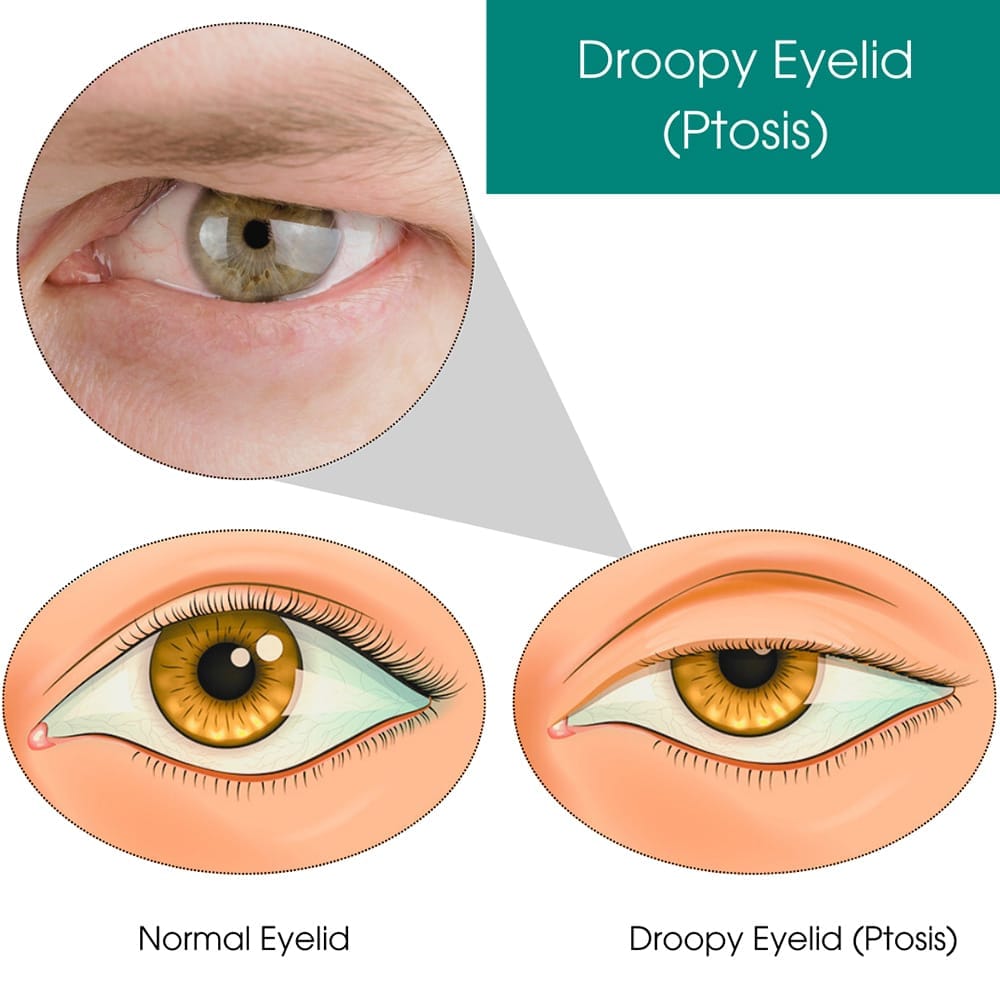Ptosis is characterized by the drooping, sagging, or falling of the upper eyelid over the eye. This generally happens because the muscle that lifts the eyelid, the levator, is not working appropriately. Depending on the drooping of the eyelid, the condition might limit vision slightly or totally. Ptosis can affect one or both upper eyelids and may be asymmetrical.
Ptosis can be a cosmetic and functional issue, affecting appearance and vision. The other names used for this condition are blepharoptosis, upper eyelid ptosis, or a droopy eyelid. If this condition is relatable to you, consider undergoing droopy eyelid treatment in NYC at Eye Physicians to improve your vision and overall well-being.

Ptosis can occur in both children and adults. It can be broadly divided into two main types:
Children may be born with congenital ptosis, which results from the underdevelopment of the levator muscle that elevates the eyelid. If the drooping eyelid partially blocks the child’s vision, it may cause amblyopia, also called “lazy eye.” Amblyopia is a loss of vision in an eye that doesn’t develop normal sight during early childhood, often because the eye and the brain are not working together properly.
In this case, you should first consult a ptosis doctor in NYC to address the underlying cause of amblyopia. Once you have undergone ptosis treatment in NYC, the subsequent treatment for amblyopia can begin. Our specialists offer a full range of comprehensive eye care and pediatric eye care in NYC.
The following are the causes of adult involutional ptosis:
While congenital ptosis can’t be prevented, adults can decrease the risk of developing acquired ptosis by avoiding injuries to the eye, using ptosis treatment eye drops in NYC, and getting prompt treatment for other eye conditions.
You can usually diagnose ptosis just by the way the eyelid looks. Symptoms may include:
Additionally, people with ptosis, especially children, tend to develop compensatory mechanisms to improve their vision. The most common one is tilting their heads back to improve the line of sight by looking under the drooping eyelid. For children, you might consider trying non-surgical droopy eyelid treatment. While it may not be as effective as droopy eyelid surgery, it can still be worth exploring.
Our optometrists will evaluate your symptoms, medical history, and family history of ptosis or related muscle diseases. A full examination of your eyes is conducted, and further tests like blood work, CT scans, or MRIs would be advised to determine the actual cause. After the examination, our ophthalmologists will present you with the available options for droopy eyelid treatments.
In most cases, congenital ptosis in children remains stable over time, though regular annual check-ups are important. However, age-related ptosis in adults can gradually worsen, necessitating timely intervention.
Treatment options for children’s ptosis depend on:
Eyelid ptosis surgery in NYC can be advised for poor vision. It may be performed by tightening the levator muscle or the attachment of the eyelid to some other muscles to help lift it. Ptosis treatment without surgery in NYC is also available. Other options, including eye patches, special glasses, or drops may be offered.
If vision is not affected, surgery may be delayed until the child is older. However, regular examinations are crucial as changes in eye shape during growth can exacerbate ptosis or lead to vision issues.
Surgery remains the treatment of choice for ptosis in adults, which is done under local anesthesia and often as an outpatient. During the ptosis eyelid surgery in NYC, the ophthalmologist advances or attaches the levator muscle to its normal anatomical position.
Risks after ptosis surgery may include infection, overcorrection or undercorrection of the eyelid, and swelling or bruising that might occur. That’s why it’s advisable to seek the best droopy eyelid treatment with aftercare and risk prevention.
Ptosis is drooping of the eyelid, which impacts both the appearance and the function of the lid, even affecting vision. With early diagnosis and appropriate timely treatment according to the age and condition of the patient, there can be a significant improvement in quality of life. Moreover, regular follow-ups with the ophthalmologist are necessary for the proper management of the disease. We are here to help you, contact us today and treat droopy eyelid in NYC with exceptional care!
Eye Physicians
110 Lafayette St, Suite 503
New York, NY 10013
(212) 292-4814
Entrust the care of your precious eyesight to highly skilled and experienced eye care professionals. For top-notch ophthalmologists and optometrists in Downtown Manhattan, choose Eye Physicians. Eye Physicians ensures prompt care, precise diagnosis, and personalized treatment plans.
Schedule an Appointment